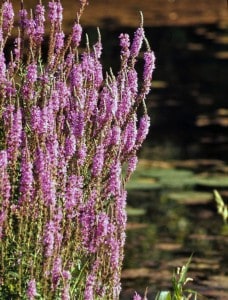
(Chelsea Update would like to thank Tm Hodgson and the Waterloo Natural History Association for the information and photos in this column.)
While driving area roads one can’t help but notice the profusion of roadside wildflowers currently in bloom.
Blossoms of blue, yellow purple, white and pink make a drive through the country-side an enjoyable experience.
Unfortunately, as colorful as they might be, many of the most common are not native at all, but foreign invaders. Some have hitchhiked their way while others were brought intentionally. Some are fairly recent arrivals, while others came with some of the first settlers.
Purple loosestrife has turned many area roadside ditches and wetlands into a sea of purple blossoms. It was brought to North America in the early 1800’s by immigrants who enjoyed its purple flowers. Seeds were also unintentionally transported to the shores of North America in the ballast water of ships.
Once purple loosestrife enters a wetland, it takes over. Common native wetland plants, such as cattails and sedges, cannot compete with purple loosestrife. Once these native plants are choked out, the wildlife that depends on them for food and shelter are also eliminated.

Purple loosestrife has little value as food for animals, and colonies of the plant become so thick that they cannot serve as cover for wildlife. Purple loosestrife also invades the shallow waters used for northern pike spawning, ruining these areas as spawning grounds.
One plant can produce several million seeds in a single summer. In addition, root and stem fragments can take root and form new plants. The non-native honey bee may be one of the few animals that benefit from purple loosestrife, as its blossoms produce an abundance of nectar, which the bees convert into a dark honey.
Once purple loosestrife is established it is very difficult to eliminate. Spraying wetlands to kill loosestrife can also endanger many native species.
More recently scientists turned to a biological control. Although honey bees benefit, there is no native North American animal that eats purple loosestrife.
To find something that eats this plant, scientists had to visit loosestrife’s native habitats in Europe and Asia. There they found the black-margined loosestrife beetle, a small insect that feeds almost exclusively on loose strife. A healthy population of loosestrife beetles can do a pretty good job of keeping purples loosestrife in check.

Before introducing it to North America scientists conducted exhaustive tests to make sure it would not start attacking valuable native plants. Native to Germany, the beetle is a purple loosestrife eating machine.
Adults feed and lay eggs on purple loosestrife leaves. After hatching; larvae eat buds, leaves and stems as they munch their way to the soil to pupate. Larvae defoliate the plant and prevent flowering and seed production.
In the early 1990s, the USDA approved the release of black-margined loosestrife beetles. Since that time they have been introduced in several locations in Michigan. The introduced beetles have reduced purple loosestrife populations on some sites by up to 95 percent, and have not been munching on any native plants.
Hopefully, the loosestrife population can be reduced to scattered plants, and native species will be able to make a come-back.
Next week we’ll explore some other alien species.













Hi Tom, I’ve also noticed the kudzu plant taking hold in this area. Talk about smothering! I’ve been trying to pull it off of my forsythia and nearby trees and shrubs. I was really surprised to see it this far north especially after the tough winter we had. I went to the web to find out more about this very invasive plant and was dismayed to see how vigorous and uncontrollable it is. I thought your article might address this newcomer. Any advice on keeping it out of our yards?
Kathleen,
Although you did not describe the plant that you believe is Kudzu, you may actually be seeing either wild cucumber or bur cucumber or both instead. Both are widespread this year due to all the rain. They are native annuals that pose no long term threat. Both look similar to Kudzu. The article I submitted for next Sunday’s Update is about these two species and includes pictures which may help with identification.